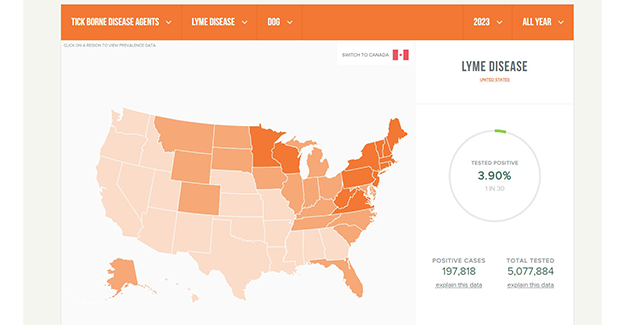Want to get your clients to listen about parasites? Keep it Local!
Click the image to go to capcvet.maps
Every year, the Companion Animal Parasite Council (CAPC) publishes an annual Pet Parasite Forecast to share predictions for risk of exposure to vector-borne pathogens including tick-borne diseases and heartworm disease across the United States and Canada.
This group of veterinarians, parasitologists, statisticians, and weather experts researches many factors that affect the likelihood of parasite spread and resultant vector-borne disease spread across North America. Among the variables they consider are temperature (both historical and forecasted), precipitation, population density, forestation, and estimations of deer populations.
CAPC uses this data to generate maps for four vector-borne diseases (heartworm disease, Lyme disease, Ehrlichia spp., and Anaplasma spp.), and they also produce a daily flea forecast.
Veterinary professionals can consult these maps to learn the expected prevalence of each disease/parasite in all parts of the US, and in the case of Lyme disease, Canada as well. They can compare these maps to previous years to see how prevalence is changing over time.
While this may be captivating reading for some of us with a strong interest and understanding of these diseases, your average pet owner likely does not care. This is the insight from CAPC CEO Christopher Carpenter, DVM, MBA.
He remembers practicing veterinary medicine in the days before the internet, where his only source of vector-borne disease prevalence information was a heartworm disease map on a poster in his exam room. It didn’t exactly inspire his clients to be more concerned about heartworm disease for their pets.
Just as we only really care about what the weather will be like right where we are on any given day, Carpenter explains, a pet owner will only respond to disease prevalence forecasts if their veterinary team can give them information that is local and timely. He recommends looking up and sharing what is going on in the county where the practice is located and the three or four counties in the surrounding area.
“People don’t want to hear about national effects,” he said.
Localized data increases compliance
Case in point: a study involving 400 corporate veterinary hospitals sent half of their clients (the control group) generic emails about parasite risks for their pets and recommended calling to set up an appointment to review their pets’ parasite-prevention needs.
The other half of the client base got an email with information on the vector-borne disease risk in their immediate area with the same recommendation to call to discuss prevention. Clients who got the local data came in for appointments at a 56% higher rate than in the control group, and they purchased 76% more preventives than the control group.
CAPC has a way for practitioners to get the local, timely information they need to help impress upon their clients the parasite risks where they live. While the annual forecasts are helpful, veterinary professionals can sign up for monthly pet disease alerts at petdiseasealerts.org and get the most up-to-date information for their local area emailed to them.
Timeliness is key to parasite prevention
Why is it important to look out for changes in parasite prevalence so frequently? “Parasites are dynamic and ever-changing,” Carpenter said.
As people travel more and take their pets with them, the risks for certain diseases can change drastically. Heartworm disease, for example, has become more prevalent in areas that previously were not thought of being high-risk for this disease. As heartworm-positive dogs travel to new areas, they raise the risk of transmission of the parasite to all other dogs in that area.
In some cases, forecasts for vector-borne disease in animals can align with the risks for the same disease in humans as well. As wildlife host populations such as deer change in either size or location, the risks for related vector-borne diseases can change along with them.
One study determined that dogs are good sentinels for Lyme disease in humans. This means that the risk on prevalence maps for Lyme disease in dogs correlates with the risk for the same disease in people.
How can veterinary professionals make the biggest impact in their community?
“Be the local expert,” Carpenter repeats. This applies to the parasites and vector-borne diseases discussed here, but also to intestinal parasites (which are not forecast by CAPC).
Research has detected seasonal variation in gastrointestinal parasite prevalence that may help practitioners better keep their patients safe and healthy. Whether it be intestinal worms or vector-borne diseases, the message is the same. Learn your local data and share your expertise with your clients.
“These messages are very powerful,” Carpenter adds, “and they get the clients to come into the clinic.”
Further reading
CAPC website:
https://capcvet.org
Pet Disease Alerts:
https://petdiseasealerts.org
Dog importation and changes in heartworm prevalence:
https://parasitesandvectors.biomedcentral.com/articles/10.1186/s13071-019-3473-0
Seasonality and changing prevalence of common canine gastrointestinal nematodes:
https://parasitesandvectors.biomedcentral.com/articles/10.1186/s13071-019-3701-7
Dogs as sentinels for Lyme disease in humans:
https://petdiseasealerts.org/about/publications/quantifying-the-relationship-between-human-lyme-disease-and-borrelia-burgdorferi-exposure-in-domestic-dogs/
Emily Singler, VMD, is a 2001 graduate of Penn State University and a 2005 graduate of University of Pennsylvania School of Veterinary Medicine. She has worked in shelter medicine, private practice, and as a relief veterinarian. She currently works as a veterinary writer and consultant and has her own blog, www.vetmedbaby.com.
Photo from capcvet.org
Disclaimer: The views expressed, and topics discussed, in any NEWStat column or article are intended to inform, educate, or entertain, and do not represent an official position by the American Animal Hospital Association (AAHA) or its Board of Directors.




